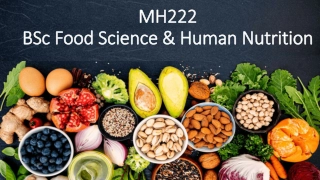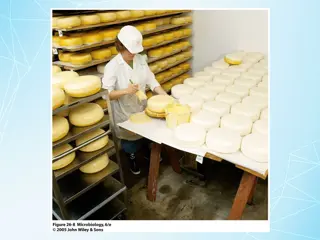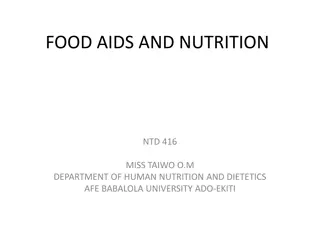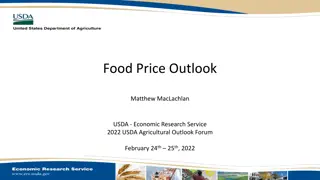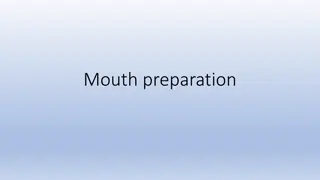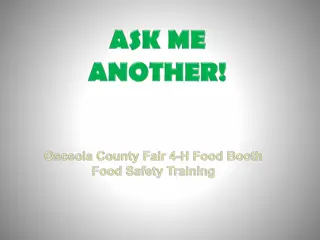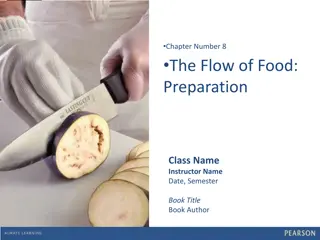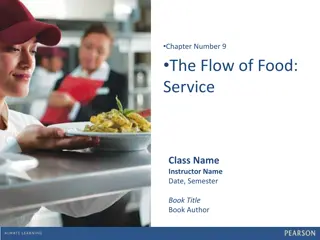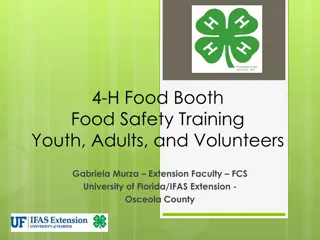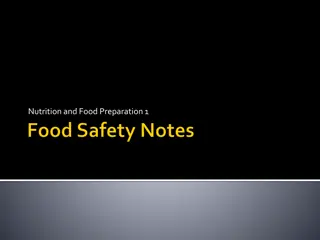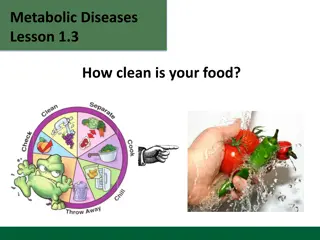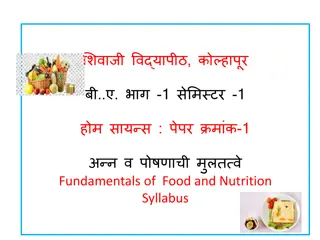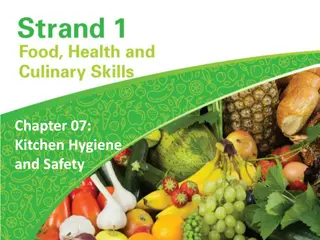
Heat Reactions in Cooking: Microwave and Pressure Cooker Insights
Dive into the realm of cooking techniques with a focus on microwave and pressure cooker methods. Explore the types of heat involved, the processes of denaturing proteins, and the breakdown of fats. Gain insight into how different foods are cooked and the science behind their transformations.
Download Presentation

Please find below an Image/Link to download the presentation.
The content on the website is provided AS IS for your information and personal use only. It may not be sold, licensed, or shared on other websites without obtaining consent from the author. If you encounter any issues during the download, it is possible that the publisher has removed the file from their server.
You are allowed to download the files provided on this website for personal or commercial use, subject to the condition that they are used lawfully. All files are the property of their respective owners.
The content on the website is provided AS IS for your information and personal use only. It may not be sold, licensed, or shared on other websites without obtaining consent from the author.
E N D
Presentation Transcript
Some reactions involved in food preparation Microwave http://www.cfs.gov.hk/english/programme/programme_rafs/programme_rafs_ft_01_02_mcfs.html Pressure Cooker http://hubpages.com/hub/stainless-steel-pressure-cooker
What is so lovely about cooking? Cooking involves the use of heat. Can we name the three types heat involved in the cooking process? The microwave is a wonderful device used for cooking. Have you ever wondered how food manages to get cooked within it. Trick question - What type of waves are involved in cooking when one uses this device?
I am sure everyone in here has cooked at some point in time. While cooking have you ever used a pressure cooker? Yes? No? Maybe so? What ever the case may be can any of you tell me how you think a pressure cooker works? Suggest the three methods by which heat can be passed on to foods. Can we explain how each method operates?
Can we explain the way that an egg is boiled using any of the suitable heating methods we deduced earlier? Hard boiled egg http://www.goodhousekeeping.com/food/cooking/how-hard-boil-egg Oh my! You all are so smart. Now, let s try to identify the heat transfers that take place in the following situations: a. A steak is grilled: b. Fish is fried: c. Vegetables simmer in your favourite sauce: d. Bread is baked: Before starchy foods are cooked the cell walls containing pectin are tough and insoluble. Upon further cooking the cell walls start getting softer however, the pectin is still somewhat insoluble as the starch granules swell and eventually gelatinize. When the starchy foods become fully cooked the pectin in the cell walls becomes soluble which enables cell separation and complete gelatinization. Let s try to draw the schematic out.
The heating of proteins cause them to be denatured. What does denaturing mean? What else causes proteins to denature? At what temperature do you presume eggs and meats start to denature? Although proteins are sensitive to heat proteins do not suffer significant loss of nutritive value when heated unless high temperatures are used. Surprise me with your knowledge! How does fat breakdown upon heating? What kind of reaction is this? What molecule, essential for life on Earth, is lost via this reaction? Frying is a type of cooking which involves the use of fat as a medium. Give me an example of this medium. We use it daily. Deep frying involves higher temperatures of 175oC-200oC. Is cooking time shorter or longer here? Under these conditions why is the loss of minerals and nitrogeneous substances small?
As glycerol loses water it contributes to the unpleasant scent of stale oil. Acrolein is mainly responsible for the smell of stale oil. So, you re in love with your belly and you love when you put bread into it. Have you ever tried to bake bread? Have you ever even considered how this Caribbean delicacy is achieved? Yeasts have been used for thousands of years in bread-making, wine-making and beer- making. When sugar and moisture are added to yeast, fermentation begins and energy is released. What is fermentation? The yeast cells then use this energy to grow and reproduce. Bread is widely made from wheat flour. What does flour contain and how does it react upon mixing it with water? What is gluten? When yeast is added to the dough meant for making bread they grow aerobically. What does aerobically mean? C12H22O11+ H2O 2C6H12O6 The above reaction shows glucose being made from sucrose
a. Enzymes to convert the starch in the flour to maltose b. The fibres of the gluten then stretch enabling the formation of an elastic framework which manages to trap the CO2formed. Why is CO2 important for the process of bread making. The second step involved in making the bread is kneading of the dough which causes : c. The cells then respire anaerobically. What is anaerobic respiration again? Maltose Glucose (maltose is broken down via the enzyme maltase which is present in flour) Glucose CO2+ Ethanol (glucose is broken down via zymase an enzyme found in yeast cells) The final step towards making bread is baking. What happens to the yeast in bread dough? What happens to the CO2that gets trapped within the dough as it is heated? The starch grains absorb so much water that they burst. And the bread dough begins to harden as gluten loses its elasticity and sets a crisp brown crust. What do you think the alcohol produced during bread baking is responsible for?
Let s investigate the use of raising agents. They cause food mixtures to rise. List three types of raising agents other than baking soda. Did you notice something about them all? What state are they in and what happens to them as heat is added to them? Can you see why they are considered rising agents? How is air introduced into food? List some methods for me. a. When yeasts ferment and grow b. Through the use of sodium hydrogencarbonate or baking powder. Below is the following reaction for this: 2NaHCO3(s) Na2CO3(s)+ H2O(g)+ CO2(g) Carbon dioxide is introduced into food mixtures in two ways:
How do you like your meat? Tough or Tender? Hmmm... Meat that has been cooked is more tender than when it is uncooked. But there are instances when cooking meat doesn t accomplish tenderizing. What do you suggest as a resolution for this? There s also an unconventional way for tenderizing meat. This is referred to as mechanical tenderizing. Ever played tennis or cricket with the same ball? What happens to the ball overtime? Well it is the same concept here. Enzymes can also be used to tenderize meat. Did you know that papaya and pineapple can aid in the tenderization of meat? How is this so? Papaya http://www.sharingsustainablesolutions.org/papaya-planting-tips-for-seed-variety-selection-germinating-growing-and-harvesting/ The tenderizing action results from the hydrolysis of the amide linkages of the protein in meat. Pineapple http://www.google.com/images?q=pineapple&hl=en&prmd=ivnsue&source=lnms&tbs=isch:1&ei=fEeVTb34JqST0QGU7KWJDA&sa=X&oi=mode_link&ct=mode&cd=2&sqi=2&ved=0CBQQ_AUoAQ&biw=1366&bih=587
Ascorbic acid better known as vitamin C, C6H8O6, can be obtained via various fruits such as cherries, citrus fruits or black currents. It also aids us in quelling the common cold. Vitamin C is water soluble and easily oxidized. How may oxidation be increased? Can you explain why bananas or any kind of citrus fruits turn brown once their skins have been peeled? Oranges contain a natural source of Vitamin C http://www.flickr.com/photos/voetmann/345453004/ Vitamin C gets lost when fruits and vegetables are stored. Cooking is also a culprit here as it causes vitamin C to break down. Vitamin C controls the formation of dentine, cartilage and bone. Where is dentine found in the body? Artificial source of vitamin C http://www.google.com/images?hl=en&biw=1366&bih=587&tbs=isch%3A1&sa=1&q=vitamin+c&aq=f&aqi=g10&aql=f&oq=


